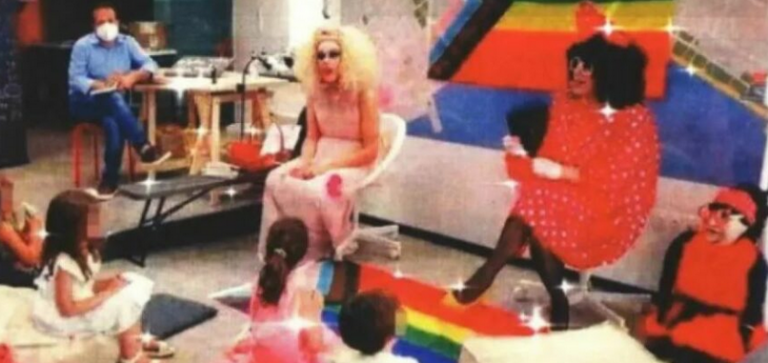Drag Queen Story Hour—in which performers in drag read books to kids in libraries, schools, and bookstores—has become a cultural flashpoint. The political Right has denounced these performances as sexual transgressions against children, while the political Left has defended them as an expression of LGBTQ pride. The intellectual debate has even spilled into real-world conflict: right-wing militants affiliated with the Proud Boys and the Three Percenters have staged protests against drag events for children, while their counterparts in the left-wing Antifa movement have responded with offers to serve as a protection force for the drag queens.
Families with children find themselves caught in the middle. Drag Queen Story Hour pitches itself as a family-friendly event to promote reading, tolerance, and inclusion. “In spaces like this,” the organization’s website reads, “kids are able to see people who defy rigid gender restrictions and imagine a world where everyone can be their authentic selves.” But many parents, even if reluctant to say it publicly, have an instinctual distrust of adult men in women’s clothing dancing and exploring sexual themes with their children.
These concerns are justified. But to mount an effective opposition, one must first understand the sexual politics behind the glitter, sequins, and heels. This requires a working knowledge of an extensive history, from the origin of the first “queen of drag” in the late nineteenth century to the development of academic queer theory, which provides the intellectual foundation for the modern drag-for-kids movement.
The drag queen might appear as a comic figure, but he carries an utterly serious message: the deconstruction of sex, the reconstruction of child sexuality, and the subversion of middle-class family life. The ideology that drives this movement was born in the sex dungeons of San Francisco and incubated in the academy. It is now being transmitted, with official state support, in a number of public libraries and schools across the United States. By excavating the foundations of this ideology and sifting through the literature of its activists, parents and citizens can finally understand the new sexual politics and formulate a strategy for resisting it.
Start with queer theory, the academic discipline born in 1984 with the publication of Gayle S. Rubin’s essay “Thinking Sex: Notes for a Radical Theory of the Politics of Sexuality.” Beginning in the late 1970s, Rubin, a lesbian writer and activist, had immersed herself in the subcultures of leather, bondage, orgies, fisting, and sado-masochism in San Francisco, migrating through an ephemeral network of BDSM (bondage, domination, sadomasochism) clubs, literary societies, and New Age spiritualist gatherings. In “Thinking Sex,” Rubin sought to reconcile her experiences in the sexual underworld with the broader forces of American society. Following the work of the French theorist Michel Foucault, Rubin sought to expose the power dynamics that shaped and repressed human sexual experience.
Twitter user growth is at a record high in Elon Musk’s first week
Do you want this in your kid’s school? https://t.co/CGT8IAB1Jd pic.twitter.com/66OIRp4IUh
— Libs of TikTok (@libsoftiktok) November 6, 2022
“Modern Western societies appraise sex acts according to a hierarchical system of sexual value,” Rubin wrote. “Marital, reproductive heterosexuals are alone at the top erotic pyramid. Clamouring below are unmarried monogamous heterosexuals in couples, followed by most other heterosexuals. . . . Stable, long-term lesbian and gay male couples are verging on respectability, but bar dykes and promiscuous gay men are hovering just above the groups at the very bottom of the pyramid. The most despised sexual castes currently include transsexuals, transvestites, fetishists, sadomasochists, sex workers such as prostitutes and porn models, and the lowliest of all, those whose eroticism transgresses generational boundaries.”
Rubin’s project—and, by extension, that of queer theory—was to interrogate, deconstruct, and subvert this sexual hierarchy and usher in a world beyond limits, much like the one she had experienced in San Francisco. The key mechanism for achieving this turn was the thesis of social construction. “The new scholarship on sexual behaviour has given sex a history and created a constructivist alternative to” the view that sex is a natural and pre-political phenomenon, Rubin wrote. “Underlying this body of work is an assumption that sexuality is constituted in society and history, not biologically ordained. This does not mean the biological capacities are not prerequisites for human sexuality. It does mean that human sexuality is not comprehensible in purely biological terms.” In other words, traditional conceptions of sex, regarding it as a natural behavior that reflects an unchanging order, are pure mythology, designed to rationalize and justify systems of oppression. For Rubin and later queer theorists, sex and gender were infinitely malleable. There was nothing permanent about human sexuality, which was, after all, “political.” Through a revolution of values, they believed, the sexual hierarchy could be torn down and rebuilt in their image.
Read more: City Journal
Ask me anything
Explore related questions





